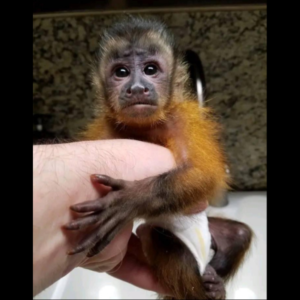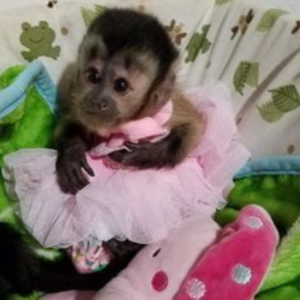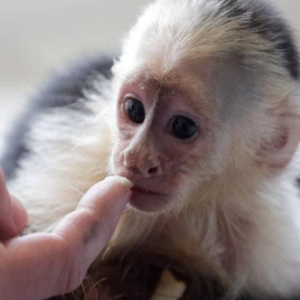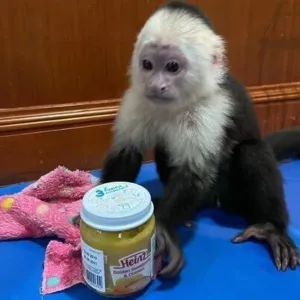If you want heath male or female Capuchin monkey for sale, welcome in right monkey pet shop. Primate available in the store include finger monkey All monkeys are breeds in captivity.
babies capuchin monkey
$3,800.00cute baby capuchin monkey
$1,100.00cutest baby capuchin monkey
$1,100.00cutest capuchin monkey
$1,100.00female capuchin monkey
$1,100.00hand raised capuchin monkey
$1,100.00little buddy capuchin monkey
$1,100.00male capuchin monkey
$1,000.00tamed capuchin monkey
$1,000.00very cute capuchin monkey
$1,100.00white face capuchin monkey
$1,100.00young capuchin monkey
$1,000.00A capuchin monkey is a cuddly, playful primate that lives in the forests of Central and South America. They’re also one of the world’s cutest monkeys, and they’re available for sale through some pet stores in the United States. If you want to buy a capuchin monkey, you can do so here.
Capuchin monkeys are cute, adorable animals that make great pets. If you have room for a capuchin monkey in your home, then by all means, they are the perfect pet. You’ll need to provide a cage and some toys, such as string toys. You will also need to feed it twice a day, giving it vegetables and fruit. They need a place to sleep and some sort of hammock or swing. If you have a nice garden they can play in, they will appreciate it. Also, they like to chew on things that are not safe for them, like clothes and shoes. So be careful when you leave your monkey in the room.
It’s important to regularly clean their cage and the area around it. This will prevent your capuchin monkey from getting sick. To do this, take newspapers and place them on the floor of the cage so that they can use them as bedding. This will make it easier for them to keep their home clean. You will also need to change the litter in the cage regularly.
If your capuchin monkey has a house that is not very clean, it can make him sick. Monkeys tend to spend a lot of time outdoors and are therefore exposed to different types of germs. Your capuchin monkey can pick up these germs and pass them on to other animals in his house. If you don’t clean the cage frequently, the monkeys can start to catch a cold or the flu. So it’s important that you clean their cage and the surrounding area every day.
Cleaning their cage and the area around it will ensure hygiene. This will help prevent your capuchin monkey from getting many infections. It’s a good idea to place the newspaper in the cage. You’ll need to turn it into bedding so he can use it to keep his house clean.
A capuchin monkey needs to stay warm, so if the cage is cold, it will try to find a way to keep warm. The best way to keep them warm is to put a heat lamp in the cage. Leave the lamp on overnight to keep them warm. Make sure the light is bright and not too close to your capuchin monkey so it doesn’t get burned.
The Capuchin is one of those endearing little monkeys. They also have big, bright and expressive eyes that echo great intelligence. We suggest you know more about this monkey full of qualities.
the capuchin monkey family Cebidae
The term Capuchin refers to several monkeys. Scientifically, the family Cebidae includes 4 genera:
Some authors add the Callitrichidae family, represented by the Ouistitis, the Tamarins, the Pinches and the Lion Monkeys.
However, when we look at the vernacular names of the monkeys, some are designated as Sapajou whereas they are Cebus. There is therefore something to lose… Here are some examples. The Brown Capuchin (Sapajus apella) is also called Sapajou apelle, Black Sajou, Sajou apelle, or Black-tailed Capuchin. The yellow-breasted capuchin (Sapajus xanthosternos) is sometimes called yellow-breasted capuchin. The White-headed Capuchin (Cebus capucinus) is also known as Monkey Monkey, Monk Monkey, White-faced Sapajou or simply Capuchin.
The Capuchin group life
Capuchins’ behaviors vary according to their environment and the size of their group which includes between 5 and 40 individuals. The dominant male has only a few advantages without being really comparable to the leader.
Capuchin groups are very mobile and travel an average of 2 kilometers per day on a global territory of about 30 square kilometers on average. In case of a threat, males gather and show their teeth while uttering shrill cries whose role is both to alert the group and to frighten the intruder.
Males move around more than females and may even leave their group to join another.
What the Capuchin eats
The Capuchin is omnivorous. Its diet depends of course on what it finds in its environment. The forests where it lives provide it with fruits, seeds, nuts and insects. It also eats spiders, birds, lizards, eggs, mollusks and even small mammals like squirrels. It lives in trees and only comes down to the ground to drink.
The composition of its diet also depends on the size of the group in which it lives. Scientists have observed that the larger the group, the greater the proportion of protein in the Capuchin’s diet, and the smaller the group, the greater the proportion of fruit.
The hypothesis formulated to explain this evolution of behavior is that a territory provides a limited amount of food. A small group of monkeys is more vulnerable than larger ones. They will therefore consume food that is not very competitive, turning to other food sources, also coveted by other animals, only in the event of a shortage. Conversely, larger groups are more independent of competition and turn more readily to more immediately available food sources.
The Capuchin’s intelligence
The Capuchin monkey is very intelligent. It has been observed using a stick to reach insects in inaccessible areas with its paws, using stones selected for their sharpness to peel and break solid-shelled fruits or to shell prey, and even using rudimentary spikes as weapons, to skewer prey or defend itself against an opponent. It can use its long tail to lead prey astray, believing it is being attacked on one side, and then fleeing to the other, towards the monkey. It rubs its coat with the pulp of certain fruits to get rid of its parasites or to protect its skin, as we would do with a cosmetic cream.
This intelligence makes it difficult to capture by means of a trapped cage. Even if the cage is perfectly concealed, the Capuchin does not fall into the trap. Only a net stretched above him outside his field of vision is effective.
But to want to make the Capuchin a pet is idiocy because in captivity, it loses much of its alertness. The best is to observe it in the wild, in the National Parks of Central and South America. It is not very shy and often comes to meet visitors who lure it with food. However, this practice is not encouraged so as not to make the animals dependent on humans.
Proximity to human beings
What is perhaps most fascinating about the Capuchin is its face, which has only a few white hairs and reveals pale pink skin. This gives the primate human-like features, which particularly struck the Swedish naturalist Carl Linnaeus (1707-1778).
The Capuchin has a “semi-opposite” thumb which limits its ability to grasp objects. Nevertheless, he remains very dexterous.
Capuchins do not have a dedicated breeding season: they reproduce all year round, like human beings. However, the comparison stops there because the males are polygamous, their objective being to fertilize as many females as possible. Polyandry is also frequent: females often mate with several males, showing themselves capable of coitus interruptus (the male is rejected before the emission of sperm).
What threatens the Capuchin
Snakes, caimans, jaguars or even ocelots threaten them. For this reason, the Capuchins rarely return to the ground because the heights are safer for them. However, the air is also a threat, and probably the worst, because the forest eagle, the ferocious harpy, evolves there. To protect themselves, the monkeys in a group take turns standing guard to give the alarm in case of a threat.
The escape is not systematic and it happens that a group decides to confront the enemy, without the scientists being able to explain the decision. The size of the group is undoubtedly a factor, but it is not the only element in the decision. Large groups may flee from a snake, while smaller groups may decide to confront a jaguar. Capuchin populations are not threatened, but deforestation is limiting their natural habitat.
Do capuchin monkeys make good pets?
Capuchins, like other primates, are not good pets. They are not happy in a family environment and can become aggressive. They need the company of other capuchins and plenty of space for exercise. But with proper training and care, they can make perfect pets.
How do you get a capuchin monkey in NC?
The North Carolina Wildlife Resources Commission states that it is legal to keep a monkey such as a capuchin monkey. Provided the owner has a valid permit issued by the Commission. Exotic animal websites such as exoticanimalpet.com specialize in the sale of capuchin monkeys.
What is the lifespan of a capuchin?
A Capuchin living freely in the wild has an average life expectancy of 20 years. In captivity, it can live up to 35 years with appropriate care
Are capuchin monkeys cuddly?
Capuchin monkeys display incredible adaptability, intelligence and social skills, making them a highly prized primate in the world of exotic pets. Although Capuchin monkeys are cute and cuddly, caring for a Capuchin involves serious risks and responsibilities.












